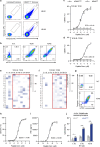Identification of novel KRASG12D neoantigen specific TCRs and a strategy to eliminate off-target recognition
- PMID: 39819441
- PMCID: PMC11740425
- DOI: 10.1186/s12967-025-06094-1
Identification of novel KRASG12D neoantigen specific TCRs and a strategy to eliminate off-target recognition
Abstract
Background: T cell receptor (TCR)-engineered T cells targeting neoantigens originated from mutations in KRAS gene have demonstrated promising outcomes in clinical trials against solid tumors. However, the challenge lies in developing tumor-specific TCRs that avoid cross-reactivity with self-antigens to minimize the possibility of severe clinical toxicities. Current research efforts have been put towards strategies to eliminate TCR off-target recognition.
Methods: Naive T cell repertoire was used for screening KRASG12D-reactive TCRs. Specific TCRs were subsequently identified and their functionality was assessed using TCR Jurkat cells and TCR T cells. Peptide specificity was evaluated using the X-scan assay. To enhance TCR specificity for KRASG12D and reduce their reactivity to self-peptide SMC1A29-38, mammalian TCR display libraries were employed for the design of modification in the complementarity-determining region (CDR).
Results: HLA-A*11:01-restricted TCRs targeting the KRASG12D epitope were isolated, and TCR1 was characterized with superior functional avidity and specificity. Alongside a robust recognition of endogenous KRASG12D epitope, this TCR displayed cross-reactivity with the SMC1A29-38 epitope. With an approach utilizing structural-guided mutations in the CDR-1A region of TCR1, we obtained an engineered TCR variant (TCR1a7). Functional characterization of TCR1a7 showed that this TCR not only exhibited enhanced specificity towards KRASG12D, but also demonstrated successful elimination of the off-target recognition of SMC1A29-38.
Conclusions: TCRs targeting the KRASG12D peptide could be isolated from naive T cell repertoires. Integrating the TCR-peptide-HLA complex structure with a mammalian TCR library system could serve as a functional strategy to reduce potential TCR cross-reactivity with self-antigens, such as SMC1A29-38. Our findings evidenced an operable method to enhance TCR peptide specificity, while maintaining advanced functional avidity and potent anti-tumor activity.
Keywords: Cross-reactivity; KRAS mutation; Off-target; T cell receptor.
© 2025. The Author(s).
Conflict of interest statement
Declarations. Ethics approval and consent to participate: This study was approved by the Ethics Committee of The First Affiliated Hospital of Chongqing Medical University ( the approval number: 2023–234). All individuals signed an informed consent form. Consent for publication: Not applicable. Competing interests: Patent has been filed for KRASG12D specific TCRs presented here. All other authors declare no competing interests.
Figures





Similar articles
-
Therapeutic potential of T-cell receptor targeting the HLA-A*11:01-restricted KRASG12V neoantigen without cross-recognition of the self-antigen RAB7B in solid tumors.J Immunother Cancer. 2025 Jul 18;13(7):e011863. doi: 10.1136/jitc-2025-011863. J Immunother Cancer. 2025. PMID: 40681176 Free PMC article.
-
Functional avidity enhancement of a T-cell receptor targeting the KRASG12D cancer neoantigen.Cell Immunol. 2025 Aug;414:104999. doi: 10.1016/j.cellimm.2025.104999. Epub 2025 Jun 23. Cell Immunol. 2025. PMID: 40582295
-
High-affinity oligoclonal TCRs define effective adoptive T cell therapy targeting mutant KRAS-G12D.Proc Natl Acad Sci U S A. 2020 Jun 9;117(23):12826-12835. doi: 10.1073/pnas.1921964117. Epub 2020 May 27. Proc Natl Acad Sci U S A. 2020. PMID: 32461371 Free PMC article.
-
Structural basis for T cell recognition of cancer neoantigens and implications for predicting neoepitope immunogenicity.Front Immunol. 2023 Nov 17;14:1303304. doi: 10.3389/fimmu.2023.1303304. eCollection 2023. Front Immunol. 2023. PMID: 38045695 Free PMC article. Review.
-
Targeting cancer with precision: strategical insights into TCR-engineered T cell therapies.Theranostics. 2025 Jan 1;15(1):300-323. doi: 10.7150/thno.104594. eCollection 2025. Theranostics. 2025. PMID: 39744228 Free PMC article. Review.
Cited by
-
Therapeutic potential of T-cell receptor targeting the HLA-A*11:01-restricted KRASG12V neoantigen without cross-recognition of the self-antigen RAB7B in solid tumors.J Immunother Cancer. 2025 Jul 18;13(7):e011863. doi: 10.1136/jitc-2025-011863. J Immunother Cancer. 2025. PMID: 40681176 Free PMC article.
References
-
- Yang K, Halima A, Chan TA: Antigen presentation in cancer - mechanisms and clinical implications for immunotherapy. Nat Rev Clin Oncol. 2023;20:604–23. - PubMed
MeSH terms
Substances
Grants and funding
LinkOut - more resources
Full Text Sources
Molecular Biology Databases
Research Materials
Miscellaneous

